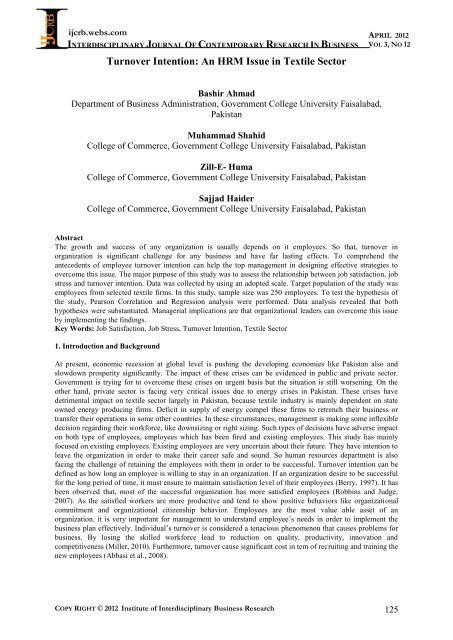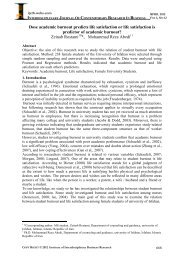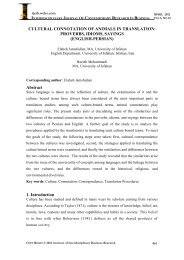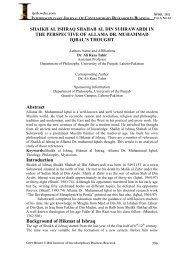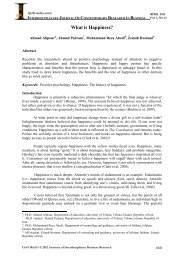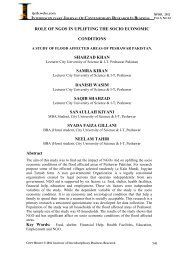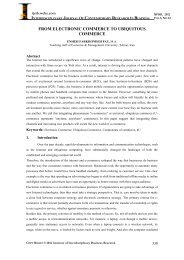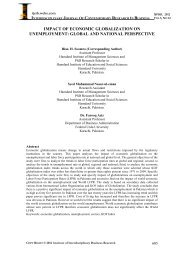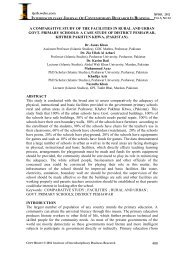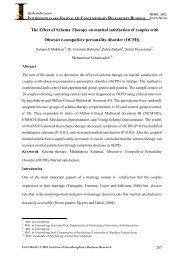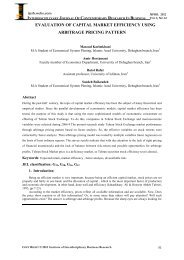Turnover Intention: An HRM Issue in Textile Sector - journal ...
Turnover Intention: An HRM Issue in Textile Sector - journal ...
Turnover Intention: An HRM Issue in Textile Sector - journal ...
Create successful ePaper yourself
Turn your PDF publications into a flip-book with our unique Google optimized e-Paper software.
ijcrb.webs.com<br />
INTERDISCIPLINARY JOURNAL OF CONTEMPORARY RESEARCH IN BUSINESS<br />
<strong>Turnover</strong> <strong>Intention</strong>: <strong>An</strong> <strong>HRM</strong> <strong>Issue</strong> <strong>in</strong> <strong>Textile</strong> <strong>Sector</strong><br />
APRIL 2012<br />
VOL 3, NO 12<br />
Bashir Ahmad<br />
Department of Bus<strong>in</strong>ess Adm<strong>in</strong>istration, Government College University Faisalabad,<br />
Pakistan<br />
Muhammad Shahid<br />
College of Commerce, Government College University Faisalabad, Pakistan<br />
Zill-E- Huma<br />
College of Commerce, Government College University Faisalabad, Pakistan<br />
Sajjad Haider<br />
College of Commerce, Government College University Faisalabad, Pakistan<br />
Abstract<br />
The growth and success of any organization is usually depends on it employees. So that, turnover <strong>in</strong><br />
organization is significant challenge for any bus<strong>in</strong>ess and have far last<strong>in</strong>g effects. To comprehend the<br />
antecedents of employee turnover <strong>in</strong>tention can help the top management <strong>in</strong> design<strong>in</strong>g effective strategies to<br />
overcome this issue. The major purpose of this study was to assess the relationship between job satisfaction, job<br />
stress and turnover <strong>in</strong>tention. Data was collected by us<strong>in</strong>g an adopted scale. Target population of the study was<br />
employees from selected textile firms. In this study, sample size was 250 employees. To test the hypothesis of<br />
the study, Pearson Correlation and Regression analysis were performed. Data analysis revealed that both<br />
hypotheses were substantiated. Managerial implications are that organizational leaders can overcome this issue<br />
by implement<strong>in</strong>g the f<strong>in</strong>d<strong>in</strong>gs.<br />
Key Words: Job Satisfaction, Job Stress, <strong>Turnover</strong> <strong>Intention</strong>, <strong>Textile</strong> <strong>Sector</strong><br />
1. Introduction and Background<br />
At present, economic recession at global level is push<strong>in</strong>g the develop<strong>in</strong>g economies like Pakistan also and<br />
slowdown prosperity significantly. The impact of these crises can be evidenced <strong>in</strong> public and private sector.<br />
Government is try<strong>in</strong>g for to overcome these crises on urgent basis but the situation is still worsen<strong>in</strong>g. On the<br />
other hand, private sector is fac<strong>in</strong>g very critical issues due to energy crises <strong>in</strong> Pakistan. These crises have<br />
detrimental impact on textile sector largely <strong>in</strong> Pakistan, because textile <strong>in</strong>dustry is ma<strong>in</strong>ly dependent on state<br />
owned energy produc<strong>in</strong>g firms. Deficit <strong>in</strong> supply of energy compel these firms to retrench their bus<strong>in</strong>ess or<br />
transfer their operations <strong>in</strong> some other countries. In these circumstances, management is mak<strong>in</strong>g some <strong>in</strong>flexible<br />
decision regard<strong>in</strong>g their workforce, like downsiz<strong>in</strong>g or right siz<strong>in</strong>g. Such types of decisions have adverse impact<br />
on both type of employees, employees which has been fired and exist<strong>in</strong>g employees. This study has ma<strong>in</strong>ly<br />
focused on exist<strong>in</strong>g employees. Exist<strong>in</strong>g employees are very uncerta<strong>in</strong> about their future. They have <strong>in</strong>tention to<br />
leave the organization <strong>in</strong> order to make their career safe and sound. So human resources department is also<br />
fac<strong>in</strong>g the challenge of reta<strong>in</strong><strong>in</strong>g the employees with them <strong>in</strong> order to be successful. <strong>Turnover</strong> <strong>in</strong>tention can be<br />
def<strong>in</strong>ed as how long an employee is will<strong>in</strong>g to stay <strong>in</strong> an organization. If an organization desire to be successful<br />
for the long period of time, it must ensure to ma<strong>in</strong>ta<strong>in</strong> satisfaction level of their employees (Berry, 1997). It has<br />
been observed that, most of the successful organization has more satisfied employees (Robb<strong>in</strong>s and Judge,<br />
2007). As the satisfied workers are more productive and tend to show positive behaviors like organizational<br />
commitment and organizational citizenship behavior. Employees are the most value able asset of an<br />
organization. it is very important for management to understand employee’s needs <strong>in</strong> order to implement the<br />
bus<strong>in</strong>ess plan effectively. Individual’s turnover is considered a tenacious phenomenon that causes problems for<br />
bus<strong>in</strong>ess. By los<strong>in</strong>g the skilled workforce lead to reduction on quality, productivity, <strong>in</strong>novation and<br />
competitiveness (Miller, 2010). Furthermore, turnover cause significant cost <strong>in</strong> tem of recruit<strong>in</strong>g and tra<strong>in</strong><strong>in</strong>g the<br />
new employees (Abbasi et al., 2008).<br />
COPY RIGHT © 2012 Institute of Interdiscipl<strong>in</strong>ary Bus<strong>in</strong>ess Research 125
ijcrb.webs.com<br />
INTERDISCIPLINARY JOURNAL OF CONTEMPORARY RESEARCH IN BUSINESS<br />
APRIL 2012<br />
VOL 3, NO 12<br />
<strong>Turnover</strong> can be categorized as voluntary turnover and <strong>in</strong>voluntary turnover. When employees decides to leave<br />
the organization their own choice, is called voluntary turnover, while, when an organization removes an<br />
employee is called <strong>in</strong>voluntary turnover (Price & Mueller 1981). Historically, it has been <strong>in</strong>vestigated that<br />
<strong>in</strong>voluntary turnover is generally good for the organizational <strong>in</strong>terest (McShane & Williams, 1993); but<br />
voluntary turnover is considered very detrimental for organization.<br />
Generally, turnover is very detrimental and costly for the organization, both voluntary and <strong>in</strong>voluntary. So,<br />
understand<strong>in</strong>g the prospective antecedents of turnover is very important to dim<strong>in</strong>ish the problem. The major<br />
purpose of this study is to identify the critical factor caus<strong>in</strong>g the turnover <strong>in</strong>tention among exist<strong>in</strong>g employees <strong>in</strong><br />
textile sector of Pakistan <strong>in</strong> order to make suggestion to reta<strong>in</strong> theses skillful workforce for organizational<br />
effectiveness. Furthermore, this study significantly helps the top management of textile <strong>in</strong>dustry to understand<br />
the needs of their employees <strong>in</strong> these circumstances and reta<strong>in</strong>ed their valuable asset with them.<br />
2. Literature Review<br />
At workplace and work<strong>in</strong>g environment, as a result they do not feel good about their job is called as response<br />
approach. F<strong>in</strong>ally, when work<strong>in</strong>g environment and affect at work, simultaneously caused stress <strong>in</strong> called<br />
stimulus-response approach. Historically, stress has been identifies as critical factor for organizational losses <strong>in</strong><br />
term f<strong>in</strong>ance as well employee health. A study on nurses’ reveals that, stress causes illness, job dissatisfaction,<br />
turnover and absenteeism (Schwab, 1996). Job stress expla<strong>in</strong>s the stress exists <strong>in</strong> work<strong>in</strong>g environment.<br />
Employees feel pressure when they found miss match between requirement of job and their capacity to work<br />
effectively. Job stress differs from organization to organization, job to job and person to person. Generally, job<br />
stress at work has a cont<strong>in</strong>gent impact on employees and cause <strong>in</strong>tention to quit the organization.<br />
Job satisfaction can be def<strong>in</strong>ed as pleasant feel<strong>in</strong>gs that reveal from an affective response to the work and<br />
work<strong>in</strong>g situation (Dipboye et al., 1994). On the hand, various scholars def<strong>in</strong>ed job satisfaction as an attitude,<br />
some consider it as behavior. Weiss (2002) argue that job satisfaction can be consider as an attitude, furthermore<br />
he suggest that to clearly conceptualize this phenomenon, researchers should <strong>in</strong>vestigate it more <strong>in</strong>tensively.<br />
Accord<strong>in</strong>g to these def<strong>in</strong>itions, first our attitude emerges about, than we feel and accord<strong>in</strong>gly respond.<br />
There are variety of factor that may <strong>in</strong>fluence the job satisfaction of employees, like pay, promotion, work<strong>in</strong>g<br />
conditions, relationship with peer and supervisors and job design. if employees found all these factors<br />
contradictory to their perceptions, they tend to be more to leave the organization. <strong>Turnover</strong> refers to leave the<br />
organization permanently. Job satisfaction and turnover <strong>in</strong>tention has native correlation. Job satisfaction,<br />
strongly <strong>in</strong>fluence the turnover of employees. At organizational level, this relationship has been widely<br />
explored. Accord<strong>in</strong>g to Hackman & Oldham (1975) has <strong>in</strong>creased relationship with greater productivity, less<br />
absenteeism, decreased employees’ turnover. Wong (1989) founds the relationship between job satisfaction and<br />
<strong>in</strong>tention quit the jobs among teachers. F<strong>in</strong>d<strong>in</strong>gs of the study were that lower the job satisfaction, lower the job<br />
commitment and performance. Furthermore teachers have more <strong>in</strong>tention to leave this job if they found some<br />
attractive benefits from someone else. On the other hand, Griffeth, et al., (2000) found a surpris<strong>in</strong>g negative<br />
relationship between job satisfaction and employee turnover. Additionally, Glance, et al., (1997) explored that<br />
turnover and productivity is positively correlated. Amah (2009) po<strong>in</strong>t out that job satisfaction has direct and<br />
negative association with turnover <strong>in</strong>tention. Jackofsky and Peter (1983) argued that association between job<br />
satisfaction and turnover <strong>in</strong>tention high, if a dissatisfy employee has belief that there are other job opportunities<br />
available <strong>in</strong> the market. Job satisfaction strongly affects the decisions related to cont<strong>in</strong>ue the exist<strong>in</strong>g job or<br />
term<strong>in</strong>ate it. It is observed that dissatisfied employees have more probability to quit the organization<br />
(Schermerhorn, et al., 2000).<br />
Job stress has identified significant area for research <strong>in</strong> the organizations now days (Gellis & Kim, 2004).<br />
Accord<strong>in</strong>g to Lazarus and Folkman (1984) stress is a vibrant association between employee and work<strong>in</strong>g<br />
environment. Job stress has been <strong>in</strong>vestigated <strong>in</strong> three forms by the researchers, some consider it as a stimulus,<br />
and several take it as a response, while certa<strong>in</strong> scholar <strong>in</strong>vestigated it as stimulus-response relationship (Jex, et<br />
al., 1992). When stress is caused by work<strong>in</strong>g environment and it harms employee performance, is called as<br />
stimulus. Accord<strong>in</strong>g to this approach, work<strong>in</strong>g environment is a real factor that causes stress.<br />
H 1 : There is a negative significant relationship between Job Satisfaction and <strong>Turnover</strong> <strong>Intention</strong>.<br />
H 2 : There is negative significant relationship between Job Stress and <strong>Turnover</strong> <strong>Intention</strong>.<br />
COPY RIGHT © 2012 Institute of Interdiscipl<strong>in</strong>ary Bus<strong>in</strong>ess Research 126
ijcrb.webs.com<br />
INTERDISCIPLINARY JOURNAL OF CONTEMPORARY RESEARCH IN BUSINESS<br />
APRIL 2012<br />
VOL 3, NO 12<br />
3. Theoretical Framework<br />
Job<br />
Satisfaction<br />
<strong>Turnover</strong><br />
<strong>Intention</strong><br />
Job Stress<br />
4. Research Methodology<br />
In this study, data was collected by us<strong>in</strong>g a self-adm<strong>in</strong>istered survey to all available employees <strong>in</strong> selected<br />
textile organizations. The questionnaire was consist<strong>in</strong>g on two major portions. Frist part consisted on<br />
demographic <strong>in</strong>formation about the employees. All the respondents were contacted by personally visit<strong>in</strong>g the<br />
organization dur<strong>in</strong>g work<strong>in</strong>g hours. Initially, 300 questionnaires were distributed and received bank 250<br />
completed questionnaires with the response rate of 83% which were considered for further data analysis. Nonprobability<br />
i.e. convenient sampl<strong>in</strong>g method was applied <strong>in</strong> this study as the research faced the issues of limited<br />
resources <strong>in</strong> term of f<strong>in</strong>ance and time. As for the questionnaire, it was an adopted questionnaire. Job stress and<br />
<strong>Intention</strong> to quit was measured by the scale designed by Firth et al., 2004, while job satisfaction was measured<br />
by the scale designed by LeRouge et al., 2006. Various statistical methods were applied to analyze the data. For<br />
this purpose, SPSS 19.0 was used.<br />
4.1. Data <strong>An</strong>alysis<br />
In this study, total respondents were 250, out of them, about 61% were male and rest of the participants was<br />
female. Age distribution <strong>in</strong> this study revealed that major portion of respond were from the age group of 31 to<br />
40 (58.4%) and only 2% were belong to age group of 51 and above which were the lowest. Most of the<br />
respondents were hav<strong>in</strong>g graduate and post graduate degrees. Results suggested that 63% graduates, 25% were<br />
post graduate and rest were hav<strong>in</strong>g other related degrees. To measure <strong>in</strong>ternal consistency of scale, Cronbach’s<br />
Alpha was implied. It has been proved that if a scale has alpha coefficient closer to 1.00, it has greater reliability<br />
(Sekaran, 2003), and the scale hav<strong>in</strong>g reliability lower than 0.60 is not considered good. Generally, scale hav<strong>in</strong>g<br />
the value <strong>in</strong> range of over 70 is considered good and acceptable. In present study, all variables have good<br />
reliabilities which are greater than 0.70. The alpha coefficient if job satisfaction is 0.916, job stress has the value<br />
of alpha 0.82 and turnover <strong>in</strong>tention 0.78. To assess the l<strong>in</strong>ear relationship among variables of the study, Pearson<br />
Correlation analysis was performed. Accord<strong>in</strong>g to Much<strong>in</strong>sky (1993), the values of correlation are started from -<br />
1.00 to +1.00. If the relationship has value closer to -1.00 that the relationship is weak and vise-versa. It is<br />
evidenced from correlational analysis of current study that job satisfaction and job stress are negatively<br />
correlated with turnover <strong>in</strong>tention. To test the hypothesis, regression analysis was used. Model summary is<br />
show<strong>in</strong>g the values of R2=0.341 and Adjusted R2=0.311 which represents the variation <strong>in</strong> depend variable due<br />
to <strong>in</strong>dependent variables. The result of ANOVA <strong>in</strong>dicate that job satisfaction and job stress has significant and<br />
negative relationship with turnover <strong>in</strong>tention with the values of F=3.52 and P= 0.005. Thus, model of this<br />
research is statistically significant. There are two significant variables <strong>in</strong> the coefficient analysis. Results shown<br />
that the beta values for job satisfaction and job stress are -0.263 and -0.265 respectively and P-value is less than<br />
significant level. So the both hypothesis of the study are supported.<br />
COPY RIGHT © 2012 Institute of Interdiscipl<strong>in</strong>ary Bus<strong>in</strong>ess Research 127
ijcrb.webs.com<br />
INTERDISCIPLINARY JOURNAL OF CONTEMPORARY RESEARCH IN BUSINESS<br />
5. Discussion, Conclusion and Future Recommendations<br />
APRIL 2012<br />
VOL 3, NO 12<br />
Current study tests the relationship between job satisfaction, job stress and turnover <strong>in</strong>tention among<br />
employees from selected textile firms. To collect data, questionnaire was distributed by personally visit<strong>in</strong>g after<br />
tak<strong>in</strong>g the permission from Human Resource Manager of the concerned firm. The format of questionnaire was<br />
as: Section first was consist<strong>in</strong>g on Personal Characteristics of respondents while second section conta<strong>in</strong>ed items<br />
related to job satisfaction, job stress and turnover <strong>in</strong>tention. Moreover, the data was analyzed by us<strong>in</strong>g the latest<br />
version of SPSS.<br />
The purpose of this study was to <strong>in</strong>vestigate the relationship among job satisfaction, job stress and<br />
turnover <strong>in</strong>tention. Hypothesis of the study were, “There is a negative significant relationship between Job<br />
Satisfaction and <strong>Turnover</strong> <strong>Intention</strong>” and “There is negative significant relationship between Job Stress and<br />
<strong>Turnover</strong> <strong>Intention</strong>”. The results suggested that job satisfaction is significantly and negatively correlated with<br />
turnover <strong>in</strong>tention. The results are consistent with the f<strong>in</strong>d<strong>in</strong>gs of Hul<strong>in</strong> (1966). Hul<strong>in</strong> test the job satisfaction<br />
among clerical level employee with relation to turnover <strong>in</strong>tention and negative impact. In 2000, Seta et al. also<br />
confirm the same f<strong>in</strong>d<strong>in</strong>gs. So these studies support the current f<strong>in</strong>d<strong>in</strong>gs also. As for the relationship among job<br />
stress and turnover <strong>in</strong>tention, job stress has significant negative relationship to turnover <strong>in</strong>tention. It has been<br />
evidenced that, employees experienced more job stress has more <strong>in</strong>tention to quit. Accord<strong>in</strong>g to Lazarus and<br />
Folkman (1984) stress is a vibrant association between employee and work<strong>in</strong>g environment. Job stress has been<br />
<strong>in</strong>vestigated <strong>in</strong> three forms by the researchers, some consider it as a stimulus, and several take it as a response,<br />
while certa<strong>in</strong> scholar <strong>in</strong>vestigated it as stimulus-response relationship (Jex, et al., 1992). When stress is caused<br />
by work<strong>in</strong>g environment and it harms employee performance, is called as stimulus. So the f<strong>in</strong>d<strong>in</strong>gs of the study<br />
are consistent with the expectation. The f<strong>in</strong>d<strong>in</strong>gs of this study are very useful for the textile sector to cope up the<br />
critical issue of the turnover <strong>in</strong>tention. These f<strong>in</strong>d<strong>in</strong>gs can help the Human Resource Managers to reduce<br />
organizational cost by reduc<strong>in</strong>g the turnover rate.<br />
This study is not without limitations, resources <strong>in</strong> term of f<strong>in</strong>ance and time was the major constra<strong>in</strong>t <strong>in</strong><br />
this study. For this reason, the data was collected only from limited cities. Furthermore, sampl<strong>in</strong>g technique was<br />
convenient sampl<strong>in</strong>g, it was also due to time factor. As, this technique is considered useful when time is limited.<br />
In the end, data was just collected for one time. In future studies, it is suggested that research may expand this<br />
work by fulfill<strong>in</strong>g the limitations of this study and also test the impact of emotional labor and organizational<br />
pride on turnover <strong>in</strong>tention.<br />
COPY RIGHT © 2012 Institute of Interdiscipl<strong>in</strong>ary Bus<strong>in</strong>ess Research 128
ijcrb.webs.com<br />
INTERDISCIPLINARY JOURNAL OF CONTEMPORARY RESEARCH IN BUSINESS<br />
References<br />
APRIL 2012<br />
VOL 3, NO 12<br />
Abbasi, S. M., Hollman, K. W., & Hayes, R. D. (2008). Bad bosses and how not to be one. Information<br />
Management Journal, 42, 52-56.<br />
Amah, O. E. (2009). Job Satisfaction and <strong>Turnover</strong> <strong>Intention</strong> Relationship: The Moderat<strong>in</strong>g Effect of Job Role<br />
Centrality and Life Satisfaction. Research and Practice <strong>in</strong> Human Resource Management, 17(1), 24-35.<br />
Berry, L.M. (1997). Psychology at Work, San Francisco: McGraw-Hill Companies Inc.<br />
Dipboye, R.L., Smith, C.S. & Howell, W.C. (1994). Understand<strong>in</strong>g and Industrial and Integrated<br />
Organizational Approach Psychology. Harcourt Brace College Publishers, Fort Worth.<br />
Firth L, David J Mellor, Kathleen A Moore, Claude Loquet (2007). How can managers reduce employee<br />
<strong>in</strong>tention to quit J. manage. Psychol. 19 (2), 170-187.<br />
Gellis, Z. D., & Kim, J. C. (2004). Predictors of depressive mood, occupational stress, and propensity to leave <strong>in</strong><br />
older and younger mental health case managers. Community Mental Health Journal, 40, 407-421.<br />
Griffeth, R. W., Hom, P. W. & Gaertner, S. (2000). A meta-analysis of antecedents and correlates of employee<br />
turnover: Update, moderator test, and research implications for the next millennium. Journal of Management,<br />
26, 463-488.<br />
Glance, N. S., Hogg, T. & Huberman, B. A. (1997). Tra<strong>in</strong><strong>in</strong>g and <strong>Turnover</strong> <strong>in</strong> the Evolution of Organizations.<br />
Organization Science, 8, 84-96.<br />
Hackman, J. R. & Oldham, G. R. (1975). Development of the job diagnostic survey. Journal of Applied<br />
Psychology, 60, 159-170.<br />
Jackofsy, E. & Peters, L. (1983). The hypothesized effects of ability <strong>in</strong> turnover process. Academy of<br />
Management Review,8, 46-49.<br />
Jex, S. M., Beehr, T. A., & Roberts, C. K. (1992). The mean<strong>in</strong>g of occupational stress items to survey<br />
respondents. Journal of Applied Psychology, 77, 623-628.<br />
Price, J.L. & Mueller, C.W. (1981). A causal model of turnover for nurses. Academy of Management Journal,<br />
24, 543-65<br />
Lazarus, R.S., & Folkman, S. (1984). Stress, Appraisal and Cop<strong>in</strong>g. New York, NY: Spr<strong>in</strong>ger.<br />
LeRouge, C., Mantzana, V., & Vance Wilson, E. (2007). Healthcare <strong>in</strong>formation systems research, revelations<br />
and visions. European Journal of Information Systems, 16(6), 669–671.<br />
McShane, M., & Williams, F. (1993). The management of correctional <strong>in</strong>stitutions. New York: Garland.<br />
Miller, Y. (2010). Labour <strong>Turnover</strong> and its Impact on Customer Service and Success of Restaurants <strong>in</strong> London.<br />
[Onl<strong>in</strong>e] Available: http://www.articleblast.com (July 6, 2010).<br />
Much<strong>in</strong>sky, P.M. (1993). Psychology Applied to Work (4th Ed.). California: Brooks/Cole Publish<strong>in</strong>g Company<br />
Price, J.L. & Mueller, C.W. (1981). A causal model of turnover for nurses. Academy of Management Journal,<br />
24, 543-65<br />
Robb<strong>in</strong>s, S.P. & Judge. T.A. (2007). Organizational Behaviour (12thed). New Jersey: Pearson Education, Inc.<br />
Schermerhorn, J.R., Jr., Hunt, J.G. & Osborn, R.N. (2000). Organizational Behaviour (7thed). New York: John<br />
Wiley & Sons, Inc.<br />
Schwab, L. (1996). Individual hard<strong>in</strong>ess and staff satisfaction. Nurs<strong>in</strong>g Economics. 1 (3), 171 173.<br />
COPY RIGHT © 2012 Institute of Interdiscipl<strong>in</strong>ary Bus<strong>in</strong>ess Research 129
ijcrb.webs.com<br />
INTERDISCIPLINARY JOURNAL OF CONTEMPORARY RESEARCH IN BUSINESS<br />
APRIL 2012<br />
VOL 3, NO 12<br />
Seta, C.E., Paulus, P.B & Baron, R.A (2000). Effective Human Resource Relations:A Guide to People at Work<br />
(4thed.). United State of America: Allyn and Bacon.<br />
Sekaran, U. (2003). Research Methods for Bus<strong>in</strong>ess (4thed.). United State of America: John Wiley & Sons, Inc.<br />
Wong, T. H. (1989).The impact of job satisfaction on <strong>in</strong>tention to change job among secondary school teachers<br />
<strong>in</strong> Hong Kong. CUHK Education Journal, 17( 2),176-85.<br />
Weiss, H. M. (2002). Deconstruct<strong>in</strong>g job satisfaction: separat<strong>in</strong>g evaluation, beliefs and affective experiences,<br />
Hum. Res. Man. Rev. 12:173-194.<br />
COPY RIGHT © 2012 Institute of Interdiscipl<strong>in</strong>ary Bus<strong>in</strong>ess Research 130


